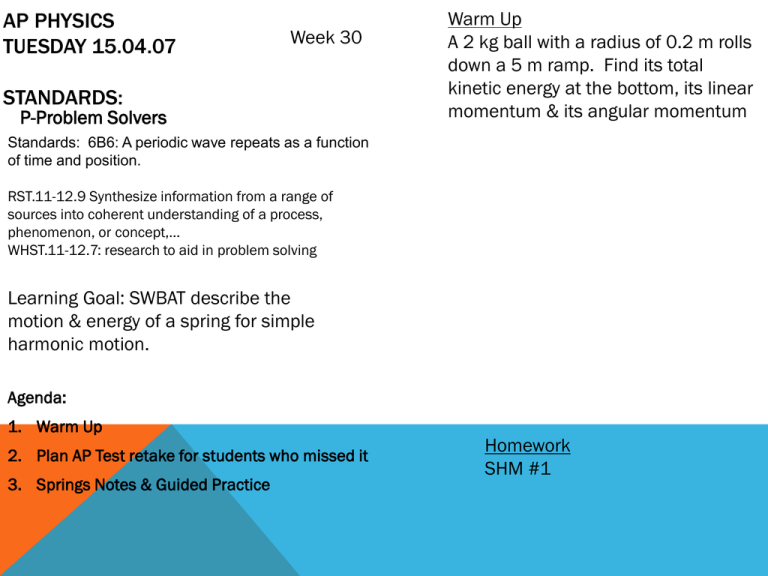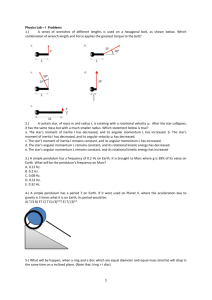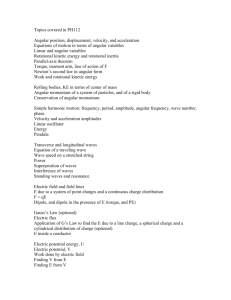15.04.07APWeek30
advertisement

AP PHYSICS TUESDAY 15.04.07 Week 30 STANDARDS: P-Problem Solvers Warm Up A 2 kg ball with a radius of 0.2 m rolls down a 5 m ramp. Find its total kinetic energy at the bottom, its linear momentum & its angular momentum Standards: 6B6: A periodic wave repeats as a function of time and position. RST.11-12.9 Synthesize information from a range of sources into coherent understanding of a process, phenomenon, or concept,… WHST.11-12.7: research to aid in problem solving Learning Goal: SWBAT describe the motion & energy of a spring for simple harmonic motion. Agenda: 1. Warm Up 2. Plan AP Test retake for students who missed it 3. Springs Notes & Guided Practice Homework SHM #1 AP PHYSICS WEDNESDAY 15.04.08 STANDARDS: D-Disciplined Learners Standards: 6B6: A periodic wave repeats as a function of time and position. RST.11-12.9 Synthesize information from a range of sources into coherent understanding of a process, phenomenon, or concept,… WHST.11-12.7: research to aid in problem solving Warm Up Spring A has a constant of 20 N/m and Spring B has a constant of 10 N/m. Find the energy and force required to displace the spring 0.25m if it is pulled by a 20kg. Which spring is more rigid? Learning Goal: SWBAT solve SHM spring problems in the vertical direction Agenda: 1. Warm Up 2. Review W#1 3. Plan Make Up AP Practice Test 4. # 17 Vertical SHM in Springs Homework W#2 AP PHYSICS THURSDAY 15.04.08 E-Effective Communicators Standards: 6B6: A periodic wave repeats as a function of time and position. RST.11-12.9 Synthesize information from a range of sources into coherent understanding of a process, phenomenon, or concept,… WHST.11-12.7: research to aid in problem solving Warm Up Spring A has a constant of 20 N/m and Spring B has a constant of 10 N/m. Find the energy and force required to displace the spring 0.25m if it is pulled by a 20kg. Which spring is more rigid? Learning Goal: SWBAT review FRQ’s for AP Torque & angular momentum exam Agenda: 1. Warm Up 2. Review HW #2 3. Pendulums 4. Take Home Test Due Tomorrow Homework W#3 AP PHYSICS FRIDAY 15.04.10 STANDARDS: P-Problem Solvers Standards: 4D net torque changes angular momentum of system I –Independent Resilient Individuals RST.11-12.9 Synthesize information from a range of sources into coherent understanding of a process, phenomenon, or concept,… WHST.11-12.7: research to aid in problem solving Warm Up a. What is the period of simple harmonic motion of a 800kN/m spring with a 50 kg mass hanging from it? b. What is the period of the simple harmonic motion of a 20 m long metal cable with a 200 kg wrecking ball attached to the end? Learning Goal: SWBAT understand the fundamentals of SHM and solve SHM problems. Agenda: 1. Warm Up 2. Turn in Take home test 3. Be ready to turn in Notebook & HW on Monday 4. Simple Harmonic Motion Review Homework Finish FRQ’s & SHM Review for Monday AP PHYSICS FRIDAY 15.03.27 Warm Up NA STANDARDS: P-Problem Solvers Standards: 4D net torque changes angular momentum of system RST.11-12.9 Synthesize information from a range of sources into coherent understanding of a process, phenomenon, or concept,… WHST.11-12.7: research to aid in problem solving Learning Goal: SWBAT explain each step of their FRQ with words in addition to solving the problem. Agenda: 1. Warm Up 2. Take FRQ quiz Homework Prepare for AP Test over Spring Break LINEAR VS ROTATIONAL EQUATIONS OF MOTION Concept Linear Position x Displacement Velocity Acceleration Equation of Motion #1 Rotational θ, Dx = x - x0 Dx v= Dt a= Dv Dt v = v0 + at x* q= r Dq = q - q0 w= v Dq w= r Dt , a= Dw Dt a ,a = r w = w0 + at Equation of Motion #2 1 Dx = v0t + at 2 2 Equation of Motion #3 v 2 = v02 + 2aDx w = w0 + 2aDq 1 Dq = w 0t + at 2 2 2 *Note: The x in rotational motion means position on the circle. More generally the equation is written s=rθ and in fact all of the linear and rotational motion equations would use an s for displacement in its most general form. 2 Extra Credit: Use the equations for rotational position,velocity & acceleration to convert the Linear Equations of Motion into the Rotational Motion Equations. #9 CENTER OF MASS LAB ACTIVITY 1. Find the center of mass of a 100 g mass at the 75 cm mark and a 200 g mass at the 25 cm mark. Will there be a net Torque associated with this center of mass? Calculate the net Torque at the center of mass. 2. Take a 20g and 40g mass. If the pivot point is at the 50 cm mark on the ruler and the 20g mass is placed at the 70 cm mark, where should you put the 40g mass to make the center of mass hit the pivot point. Calculate, then check your work by testing out your calculated position. 3. Take a 10 g mass. Place the 10g mass on the 80 cm mark. Where should you make the pivot point so that it touches the center of mass and the ruler balances? Calculate then test with a ruler and masses. 4. A 100 g mass is at the 90cm mark on a ruler that pivots at the 50 cm mark. A 500 g mass is at the 30 cm mark on the same ruler. Where would a 200 g mass need to be placed to make the center of mass hit the 50 cm mark. Calculate then verify. TAP#8 & #9 & #10 & #11 SEE SHEET ROTATIONAL MOTION OF TUMBLEBUGGY ACTIVITY #12 We understand the linear motion of a tumblebuggy, but lets also describe the angular component of motion on the tumblebuggy. 1) Find the speed of the tumblebuggy. 2) Find the angular speed of each of the tumblebuggy wheels. 3) Find the frequency and period of rotational of the tumblebuggy tires. 4) How many rpm’s does the tumblebuggy produce? 5) Write a paragraph explaining how you might attempt to find the torque produced by the wheels. Include the information and the devices you would need to use in order to measure it. #13 ANGULAR ACCELERATION LAB You will revisit the motion of objects accelerating down a ramp. Engage: Golf Ball vs Marble Rotational Motion Racing Match -Predict: Will a golf ball or a marble contain a greater angular acceleration? Will their final linear velocities be the same or different? Test: Your Objective is to compare the angular acceleration and final velocity of a golf ball vs. the marble. Object Mass (kg) distanc e (m) time1 (s) time2 (s) time3(s) tave(s) radius ( r) final velocity (m/s) final angular velocity (rad/s) linear acceler ation (m/s2) angular acceler ation (rad/s2) Marble Golf Ball Interpret: What are your results? Do they seem reasonable? Explain the physics in a paragraph. #14 ANGULAR ACCELERATION LAB 1a. Predict which dowel has more rotational inertia? 1b. Predict Which ball has more 2. Test Each Prediction 3. Gradually reduce the radius of the circle that the golf and ping pong ball make. Is it easier or harder to spin? is the rotational inertia bigger or smaller for smaller radius’s? 4. Find the rotational inertia of each object using the formulas on the back of your new sheet. I ball on string= mr2 Idowel = ½ mr2 m Fat Dowel Skinny Dowel Ping Pong Ball Golf Ball r #15 ROTATIONAL INERTIA BY ROLLING LAB Theory: When an object rolls, it has kinetic energy both in its linear (translational) motion and its rotation. The distribution of the mass about the body can affect how much energy is required to cause the spin. For example, a cart with very small wheels has almost none of its kinetic energy distributed in rolling whereas a thin hoop has a large share of its mass moving at the radial distance. In the case of an object rolling down a ramp from rest, the Total Kinetic Energy is equal to the change in gravitational potential energy ΔU=mgΔh. The total kinetic energy of a body is found by Ktotal=Ktrans+Krot=1/2 mv2+ ½ Iω2 v0=0 d v=rω h1 h2 The new symbols, I and ω, are rotational inertia and angular velocity, respectively. Where I is a constant for rigid bodies and depends on how the mass is distributed, it is usually stated as CmR2 where C is a constant between zero and 1. Angular velocity is easily found by measuring the objects velocity and converting by the formula V=Rω. Procedure: Raise a table on one side by putting a block of wood or a book under two of its legs. Allow objects of various shapes and mass distributions to roll a distance of 1.5 meters across the tilted surface. The change in height is easily measured by comparing h1 to h2 as shown. Timing the journey allows one to calculate the average translational speed, and from that the angular speed. Vaverage=1/2 (V+V0). The higher rotational inertias become evident when more energy is in the rotation. This causes a slower translational verlocity and a longer rolling time. Data: Start by measuring 1.5 m on the table top. those 1.5 m. Raise the table with the wood blocks and determine the change the height over Δh=_________ m Time the cart as it travels through this distance, fill in the chart on the next page. *** Repeat your trials until the time value is reliable. As you do the trials make sure to predict whether the object will roll faster or slower than the previous object. DO AT LEAST 4 Objects mass Radius d (m) hot wheel 1.5 blue cart 1.5 tape cylinder 1.5 cap cylinder 1.5 solid squish ball 1.5 ping pong ball 1.5 marble 1.5 solid foam disk 1.5 thick dowel 1.5 think dowel 1.5 time (s) Vave=d/t Vf=2Vavg ω=vf/R Ktotal= mgΔh Ktrans= ½ mv2 Krot= Ktot-Ktrans Rot. Inertia: Krot/2ω2 C= I/(mR2) Analysis 1. Create a list that Organizes the objects in order of rotational inertia, from largest to smallest. 2. Use conservation of energy to show that neither mass nor radius is needed to predict the final velocity. 3. Is #2 verified by experiment? For example, do both solid cylinders have the same roll time? 4. Can you understand that a disc is a solid cylinder and that a ring is a hollow cylinder? 5. Do rings and cylinders have the same fall time? Do disks and rings have the same fall time? #2 & #4 suggest they shoul. 6. Expected values for C are 1 ring/hoop/tube, ½=disc/cylinder, 2/5 solid sphere, 2/3=hollow sphere. How well (in percent) do your values match these expected values? 7. What would roll down a hill faster, a hard-boiled egg, a fresh egg, or a hollow plastic Easter egg? Explain. 8. Imagine you are at the store buying foods in cans. Would chicken broth roll down a hill faster than an empty can? What about pumpkin pie mix (sticky & thick)? 9. What was cart the fastest object today? 4. An object that is at rest, not spinning, will not spin unless acted on by an outside torque. Knowing that a torque is a force that acts at a radius, what force was causing the torque? What made the objects spin? If this force was absent what would their movement be like? 5. What are the likely sources of error that could make our measurement unreliable? How well did the experiment work ( see#6) Write a conclusion. #16 MOTION OF A SPRING NOTES & PRACTICE & SIMPLE HARMONIC MOTION OF HORIZONTAL SPRING F=-kx Usp=1/2 kx2 Guided Practice: A 2kg ball initially moving at a speed of 2m/s rolls down a ramp 10 meters high. Assume no loss of energy to rotation or fiction. The ball rolls towards a spring and depresses it 0.5m. Find k, the spring constant of the spring. #17 SIMPLE HARMONIC MOTION OF VERTICAL SPRING F=-kx Usp=1/2 kx2 T=2π(m/k)1/2 ω=(k/m)1/2 Guided Practice: A 20 N/m spring hangs from a string with a rest position 5 meters above the ground. A 1kg mass is placed on the spring, then it is stretched an extra 4 N and undergoes simple harmonic motion. a. What is the equilibrium position of the mass/spring combination? b. What is the Amplitude, angular velocity, and period of the wavelike motion of the wave? c. What is the total Mechanical Energy of the Spring? d. What is the maximum height and minimum height of the spring undergoing SHM? W#2 VERTICAL SPRINGS SHM A 2-kilogram block is dropped from a height of 0.45 meter above an uncompressed spring, as shown above. The spring has an elastic constant of 200 newtons per meter and negligible mass. The block strikes the end of the spring and sticks to it. a. Determine the speed of the block at the instant it hits the end of the spring b. Determine the force in the spring when the block reaches the equilibrium position c. Determine the distance that the spring is compressed at the equilibrium position d. Determine the speed of the block at the equilibrium position. e. Determine the resulting amplitude of the oscillation that ensues f. Is the speed of the block a maximum at the equilibrium position, explain. g. Determine the period of the simple harmonic motion that ensues W#3 SHM PENDULUM A simple pendulum consists of a bob of mass 0.085 kg attached to a string of length 1.5 m. The pendulum is raised to point Q, which is 0.08 m above its lowest position, and released so that it oscillates with small amplitude θ between the points P and Q as shown below. (a) On the figure below, draw free-body diagrams showing and labeling the forces acting on the bob in each of the situations described. i. When it is at point P ii. When it is in motion at its lowest position (b) Calculate the speed v of the bob at its lowest position. (c) Calculate the tension in the string when the bob is passing through its lowest position. (d) Describe one modification that could be made to double the period of oscillation. #18 SHM PENDULUM It is only Simple Harmonic for 30 degrees or less. It uses small angle approximation. T=2π(l/g)1/2 Δy=L(1-cosθ) A A 2kg ball on a 2m is lifted 20 degrees and let go and undergoes simple harmonic motion. a. Find the period of the motion b. Find the maximum velocity of the ball. Where does this happen? SHM REVIEW #4 A simple pendulum consists of a bob of mass 1.8 kg attached to a string of length 2.3 m. The pendulum is held at an angle of 30° from the vertical by a light horizontal string attached to a wall, as shown above. (a) On the figure below, draw a free-body diagram showing and labeling the forces on the bob in the position shown above. (b) Calculate the tension in the horizontal string. (c) The horizontal string is now cut close to the bob, and the pendulum swings down. Calculate the speed of the bob at its lowest position. (d) How long will it take the bob to reach the lowest position for the first time






